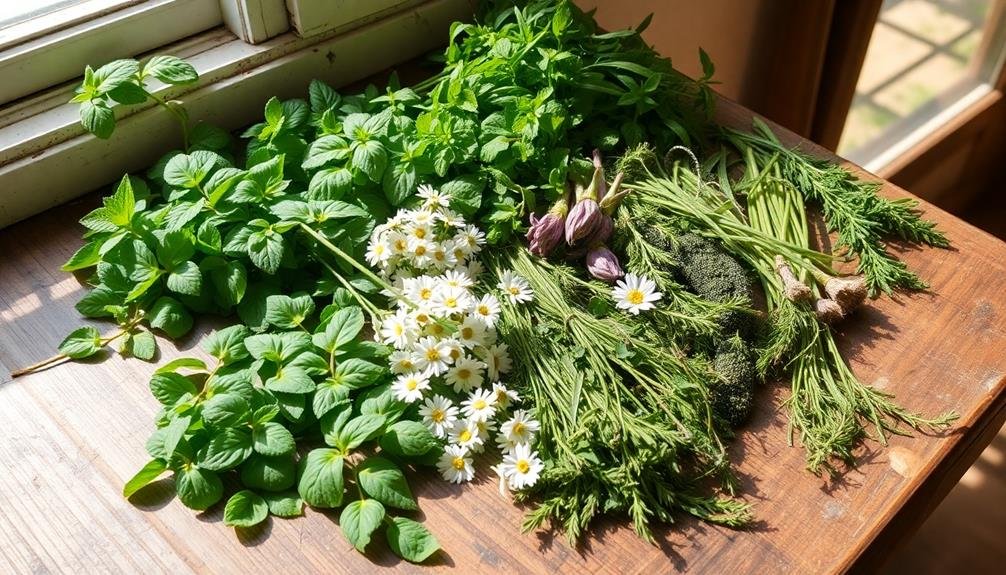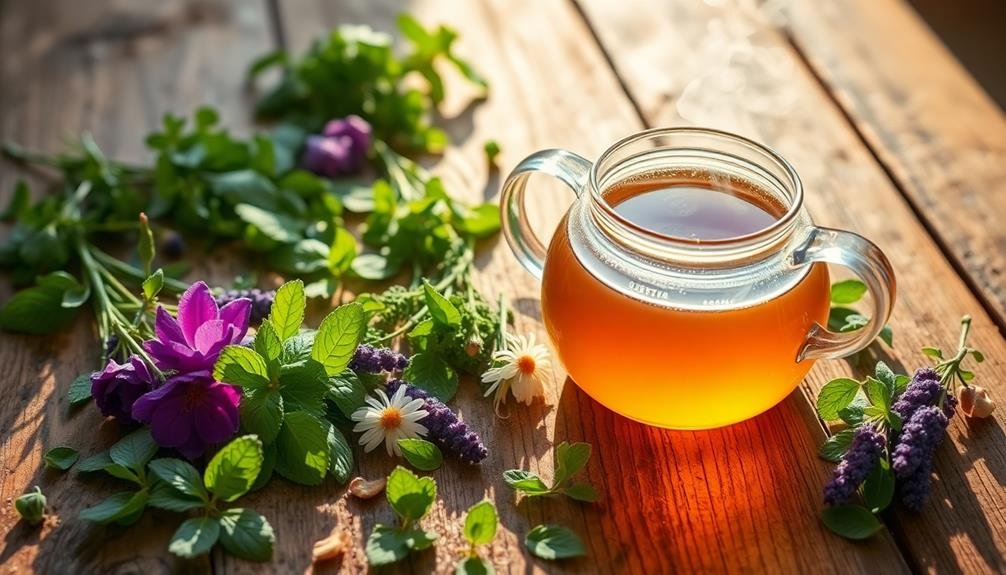When you dry herbs from your garden or local market, you release vibrant flavors for your homemade tea blends. Start by choosing herbs that match your taste, like chamomile for relaxation or peppermint for digestion. Harvest them in the morning, cutting above leaf nodes to keep plants healthy. Use methods like air drying or a dehydrator to preserve their essence. Store your dried herbs in airtight containers, away from light and heat. Finally, experiment with different combinations to create unique blends. There's so much more you can explore to make your tea experience truly special!
Choosing the Right Herbs

When it comes to crafting your own homemade tea, selecting the right herbs is essential for flavor and health benefits. Start by considering your taste preferences—do you enjoy floral notes, citrus, or earthy undertones? Popular options like chamomile, mint, and lemon balm offer unique profiles that can enhance your tea experience.
Next, think about the health benefits you want to achieve. If you're looking for relaxation, chamomile can be a soothing choice. For digestion, ginger or peppermint might be more up your alley. You can also explore herbs like hibiscus for a tart flavor and antioxidant properties or echinacea for immune support.
Don't overlook the importance of freshness. Whenever possible, opt for herbs that are either freshly harvested or sourced from reputable suppliers. Take some time to research the growth conditions and proper harvesting methods for your chosen herbs, as these factors can greatly impact flavor and potency.
Ultimately, trust your instincts and experiment with different combinations—finding your perfect blend is part of the fun. By carefully selecting herbs that resonate with your palate and wellness goals, you'll create a delightful homemade tea experience.
Harvesting Techniques for Herbs
To maximize the flavor and potency of your herbs, proper harvesting techniques are essential. Start by choosing the right time to harvest. Early morning is ideal, just after the dew has dried but before the sun gets too hot. This timing helps preserve the essential oils that contribute to your herbs' flavors.
When you're ready to pick, use clean, sharp scissors or pruning shears to avoid damaging the plants. For most herbs, cut the stems just above a leaf node, which encourages bushier growth. Be mindful not to strip the plant bare; always leave enough foliage for continued growth.
If you're harvesting woody herbs like rosemary or thyme, consider taking a few cuttings from each plant to maintain their health. For tender herbs like basil or mint, pinch off leaves regularly to promote new growth.
Always wear gloves if you're sensitive to the oils in certain herbs, and make sure to wash your hands afterward.
Once you've harvested, handle your herbs gently to prevent bruising, which can affect their flavor. Proper harvesting sets the stage for a more flavorful tea experience down the line.
Effective Drying Methods

After harvesting your herbs, it's important to dry them properly to preserve their flavor and potency. There are several effective methods you can use, depending on your preferences and resources.
One popular method is air drying. Simply tie your herbs in small bundles and hang them upside down in a cool, dark, and well-ventilated area. This method takes a week or two but retains the herbs' essential oils.
If you're short on time, consider using an oven or a dehydrator. For the oven, set it to the lowest temperature, spread your herbs on a baking sheet, and keep the door slightly ajar to allow moisture to escape. Check them every 30 minutes until they're crisp.
A dehydrator is even more efficient, allowing you to set the temperature and time for ideal drying.
Microwave drying is another quick option. Place your herbs between two paper towels and microwave in short bursts, checking frequently. This method can be fast but may result in some loss of flavor.
Choose the method that suits you best, and soon you'll have dried herbs ready for your homemade tea!
Storing Dried Herbs
Properly storing your dried herbs is essential for maintaining their flavor and potency. Start by choosing airtight containers that protect against moisture, light, and air. Glass jars with tight-fitting lids work great, but you can also use dark-colored containers to shield your herbs from harmful UV rays. Avoid plastic bags, as they can allow air and moisture to seep in, diminishing your herbs' quality.
Next, store your containers in a cool, dark place, like a pantry or cupboard. Keep them away from heat sources, such as stoves or direct sunlight, which can degrade the herbs over time. Label your jars with the herb name and drying date to keep track of freshness.
Regularly check your dried herbs for any signs of moisture or mold. If you notice any, discard those immediately.
It's also a good idea to replace your dried herbs every year to guarantee you're always working with the best flavors. With proper storage, your dried herbs will remain vibrant and ready for your homemade tea creations. Enjoy the delightful taste of your carefully preserved herbs whenever you brew!
Creating Your Tea Blends

Creating your own tea blends can be a fun and rewarding experience. Start by choosing a base herb, like chamomile or green tea. This will set the foundation for your blend.
Next, think about what flavors and aromas you enjoy. Do you prefer something floral, fruity, or spicy? Add complementary herbs to enhance your base. For example, if you choose chamomile, consider adding lavender for a calming effect or lemon balm for an invigorating twist.
Experimenting with ratios is key. Begin with a small batch, combining equal parts of your chosen herbs. Taste your blend and adjust as needed.
Don't be afraid to get creative! You can mix in dried fruits, spices, or even a touch of honey to elevate the flavor.
Once you find a blend you love, take note of the proportions. Label your creations with the name, ingredients, and date. This way, you can recreate your favorites or tweak them for future batches.
Enjoy the process, and remember that your blends can evolve over time, reflecting your changing tastes and the seasons. Happy blending!
Frequently Asked Questions
What Are the Health Benefits of Herbal Tea?
Herbal tea offers numerous health benefits. It can boost your immune system, improve digestion, reduce stress, and provide antioxidants. Drinking it regularly keeps you hydrated, promoting overall wellness and enhancing your daily energy levels.
Can I Reuse Dried Herbs for Tea?
Yes, you can reuse dried herbs for tea, but their flavor and potency will diminish with each steep. Experiment with steeping times to find a balance that suits your taste while maximizing the herbs' benefits.
How Can I Tell if Herbs Are Dried Properly?
To tell if herbs are dried properly, you should check if they crumble easily when you pinch them. They should feel dry and brittle, without any moisture. If they're still soft, they need more drying time.
Are There Any Herbs to Avoid for Tea?
You should avoid herbs like foxglove and hemlock for tea, as they're toxic. Also, steer clear of any plants you can't identify or that aren't traditionally used for tea to guarantee safety and enjoyment.
How Long Does Homemade Herbal Tea Last?
Homemade herbal tea typically lasts about 3 to 5 days in the fridge. You can extend its shelf life by freezing or dehydrating, but always check for any off smells or changes in color before using.
In Summary
Now that you know how to choose, harvest, dry, and store herbs, you're ready to create your own delightful tea blends. Enjoy the satisfaction of sipping on your homemade creations, knowing they're crafted from your own fresh herbs. Don't be afraid to experiment with different combinations and flavors; the possibilities are endless. So go on, embrace the art of herbal tea-making, and savor every aromatic cup you brew!





Leave a Reply